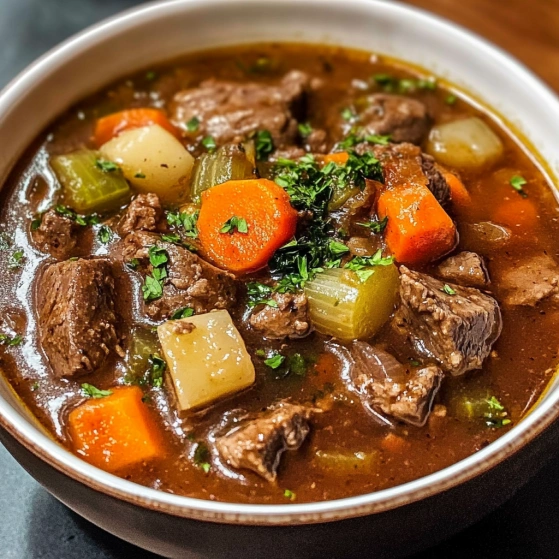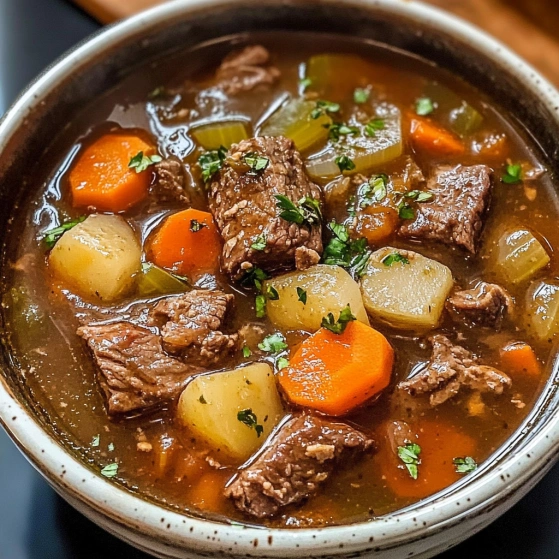 Pin it
Pin it
This hearty beef stew has been my family's cold-weather comfort food for generations. The tender beef chunks, aromatic vegetables, and rich gravy create the ultimate one-pot meal that satisfies even the pickiest eaters.
I first made this stew during a particularly harsh winter when we were snowed in for three days. The comforting aroma filled our home, and it's become our traditional Sunday dinner throughout the colder months.
Ingredients
- Beef stewing meat: Carefully select well-marbled chuck roast for the most tender results and best flavor
- All-purpose flour: Creates the perfect thickening base for the rich gravy while helping meat brown beautifully
- Red wine: Adds complexity and acidity that transforms the stew – use a wine you'd enjoy drinking
- Unsalted butter: Creates richness when combined with the beef fat – never substitute margarine here
- Onions: Both diced and quartered provide layers of sweet flavor as they slowly cook down
- Garlic: Minced garlic infuses the broth while whole cloves melt into buttery pockets of flavor
- Worcestershire sauce: Provides umami depth that enhances the beef flavor without tasting fishy
- Tomato paste: Concentrated flavor that adds richness and color to the gravy
- Beef broth: The foundation of your stew – homemade is best but low-sodium store-bought works well
- Bay leaves & thyme: Aromatic herbs that infuse the stew with classic flavor
- Root vegetables: Carrots and potatoes add heartiness and absorb the rich flavors of the broth
- Mushrooms: Provide earthy notes and meaty texture to complement the beef
Step-by-Step Instructions
- Prepare the Beef:
- Coat beef chunks thoroughly in flour mixture ensuring each piece is evenly covered. This not only seasons the meat but creates a beautiful crust when browned and helps thicken the stew later. Take time to trim excess fat but leave some for flavor.
- Brown the Meat:
- Brown beef in small batches using medium high heat. Patience is crucial here. Each batch needs about 5 minutes with minimal stirring to develop a deep brown crust that will flavor the entire stew. Overcrowding the pot will steam rather than sear the meat.
- Deglaze the Pot:
- Pour red wine into the hot pot and immediately begin scraping with a wooden spoon. Those browned bits stuck to the bottom contain concentrated flavor compounds that will transform your broth. Let the wine reduce slightly before moving to the next step.
- Build the Base:
- Sauté the onions and garlic until translucent but not browned. The butter adds richness while the aromatics release their flavors into the fat. This creates the foundation of your stew flavor before any liquid is added.
- Create the Broth:
- Combine beef stock with aromatics and browned beef allowing everything to simmer together on low heat. This slow cooking breaks down the tough connective tissue in the beef while infusing the broth with layers of flavor from the herbs and meat.
- Add Vegetables:
- Add vegetables at the right time to prevent them from overcooking. The oven method ensures even slow cooking and prevents scorching at the bottom of the pot. The vegetables will absorb the rich flavors while maintaining their distinct textures.
 Pin it
Pin it
The bay leaves might seem optional but they contribute an aromatic quality that simply cannot be replicated with other herbs. My grandmother would count them before serving to make sure none remained in the finished stew. Her secret was adding an extra bay leaf when reheating leftovers to refresh the flavor.
Make-Ahead Tips
This stew improves with time making it perfect for meal planning. Make it up to three days ahead and store in an airtight container in the refrigerator. The flavors continue to develop as it sits. When reheating on the stovetop add a splash of beef broth if needed to adjust consistency. For even better results refrigerate uncooked stew after step 5 then complete oven cooking the day you plan to serve it.
 Pin it
Pin it
Perfect Pairings
Serve this hearty stew with crusty sourdough bread or warm dinner rolls for sopping up every last bit of gravy. For a complete meal pair with a simple green salad dressed with vinaigrette to cut through the richness. Red wines like Cabernet Sauvignon or Merlot complement the deep flavors perfectly. For a special touch try serving in bread bowls for an impressive presentation that delights both family and guests.
Troubleshooting Tips
If your stew turns out too thin whisk 2 tablespoons cornstarch with 2 tablespoons cold water and stir into simmering stew until desired thickness is reached. Tough meat typically means it needs more cooking time not less. Return to low heat covered for another 30 minutes. If vegetables are cooking unevenly cut larger vegetables into smaller pieces than faster cooking ones like potatoes slightly larger than carrots.
Frequently Asked Questions
- → What's the best cut of beef for stew?
Chuck roast is ideal for beef stew because it has excellent marbling and becomes tender when slow-cooked. Other good options include bottom round, rump roast, or brisket. These tougher cuts break down beautifully during the long cooking process, resulting in melt-in-your-mouth meat.
- → Can I make beef stew in a slow cooker instead?
Yes! Brown the meat and sauté the aromatics as directed, then transfer everything to a slow cooker. Add the vegetables and cook on low for 7-8 hours or on high for 4-5 hours. Add the potatoes and mushrooms during the last 1-2 hours to prevent them from becoming mushy.
- → How do I thicken beef stew if it's too watery?
Make a cornstarch slurry by mixing 1-2 tablespoons of cornstarch with equal parts cold water. Bring the stew to a simmer and slowly stir in the slurry. Cook for 2-3 minutes until thickened. Alternatively, you can mash some of the cooked potatoes against the side of the pot to naturally thicken the broth.
- → Can beef stew be made ahead of time?
Absolutely! Beef stew actually improves in flavor when made a day ahead. Let it cool completely, then refrigerate overnight. The next day, remove any solidified fat from the top, then reheat gently on the stovetop until hot throughout.
- → What's the best way to store and reheat leftover beef stew?
Store leftover beef stew in an airtight container in the refrigerator for up to 4 days. For longer storage, freeze in portion-sized containers for up to 3 months. To reheat, thaw overnight in the refrigerator if frozen, then warm gently on the stovetop over medium-low heat, adding a splash of broth if needed to restore consistency.
- → Can I substitute the red wine in beef stew?
Yes, you can substitute red wine with additional beef broth plus 1 tablespoon of red wine vinegar or balsamic vinegar to add acidity. For depth of flavor, you can also add 2 tablespoons of tomato paste when sautéing the vegetables.
